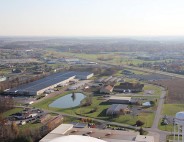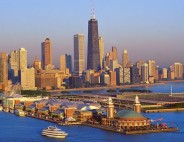Indiana Focuses on a Good to Great Strategy
13 Jan, 2014
By David Hodes
Indiana Secretary of Commerce Victor Smith says that Gov. Mike Pence has made it very clear that the administration has one goal. “And that is more Hoosiers working than at any other time in our state’s history.” Smith works closely with the Indiana Economic Development Corp., which markets the state’s business climate advantages.
Smith says that being from the private sector as a partner who ran a manufacturing company makes him very data driven. “I am one of those guys who likes to be where the rubber hits the road,” Smith says. Armed with data sets, Smith and the administration have put together a plan they called “Good to Great,” which is designed to increase private sector employment and improve the quality of the Hoosier workforce.
“We are starting kind of on second base and it’s all about continuity and aspirations as far as I am concerned,” Smith says. “Continuity in the sense that we are going to continue to honor the fiscal discipline. And aspirations are where the great comes in.”
Along those lines, Indiana’s officials have passed the largest tax cut in state history as part of the new two year $30 billion budget. They have also enacted legislation that lowers the individual income tax each year for the next four years.
The state is also in the black as far as its operating budget, and every year they add “about a half billion dollars” to their surplus, Smith says. “We have 14 percent of our operating budget in cash reserves right now, which is unheard of.”
Smith says the state’s unemployment rate is near 8 percent, which means the administration’s plan is a work in progress. “Our fiscal discipline has allowed us the flexibility to make inward investment at a time when other people simply can’t,” he says. “We have that luxury. Other people do not.”
Industries and Innovations
Cinda Kelley, executive director of Hendricks County Economic Development Partnership, says that the county primarily targets three industries. “No. 1 is logistics, and it’s our No. 1 growth sector as well,” she says. The county has 38 million square feet in place to support the industry. Hendricks County provides companies with access to the Hendricks County-Gordon Graham Field and the FedEx national hub at the Indianapolis International Airport.
A two-hour drive due north of Hendricks County is Wabash County, where value-added agriculture has become a big target industry, says Bill Konyha, president and CEO, Economic Development Group of Wabash County Inc.
Efforts around health care and biosciences have gotten a boost recently in the county because of the improved fiber optics service to this rural area, which came about thanks to the tax increment financing vehicle they used to leverage that investment. “We invested $1.7 million of a $20 million investment by Cinergy MetroNet,” Konyha says. The company ran fiber optic cable between the city of Wabash and the town of North Manchester along Indiana State Highway 15. “All of Wabash and North Manchester — every building has fiber optic service directly into the building,” Konyha says.
In other state-level activities, Jeff Quyle, economic development coordinator at Hoosier Energy, says that when Honda announced they were going to build a plant in Greensburg, (the 1,600-acre Honda Manufacturing of Indiana is now five years old) the land was served by rural electric lines in Decatur County.
As the energy supplier to Decatur, Hoosier Energy wanted to make sure that they did everything possible to give Honda the reliability and affordability that they were looking for in electricity, Quyle says. Hoosier Energy built a new transmission line to give Honda redundant power, and invested $24 million in that and other upgrades. “Honda came in and was able to run two shifts immediately,” he says.
Quyle says that Indiana’s officials are taking steps to be more attractive to data centers, a key business win for a power generation company because of the large energy usage required by data centers, but also because they recognize that “both the east and west coasts have been enjoying the fruits of the growth in that sector.”
To support data center investments, Indiana passed a new incentive program a couple of years ago that gives a 100 percent long-term abatement from personal property taxes on data centers.
Talent and Education
Hendricks County’s officials are adding training opportunities in the county. The Midwest Technical Institute built a facility in the Brownsburg area that is a 15-minute drive from Indianapolis. Courses include welding, pipefitting and HVAC training.
At the state level, Smith says it is an exciting time for the state’s biosciences industry. The sector is a $45 billion per year industry in the state, which is represented by Indianapolis-based companies such as Roche USA (the company’s North American headquarters); and Eli Lilly and Co. (the company’s global headquarters). The state of Indiana has invested $25 million to fund the Indiana Biosciences Research Institute. Companies such as Biomet, Cook Medical, Roche and Lilly, as well as some of the state’s largest universities, will match the $25 million to support the institute. This statewide public-private partnership is being touted as the first industry-led collaborative life sciences research institute in the country.
Assets
In regard to infrastructure developments, the Hoosier highway recently opened in Wabash County, providing four-lane connectivity from Interstate 65 to Interstate 69. Located less than a quarter of a mile from the new highway is the 242-acre pad-ready Wabash Business Park. “We feel that we are positioned strongly for development of that park,” Konyha says.
Quyle says that Hoosier Energy is working on both the demand side and the supply side of customer’s power needs. On the supply side, the utility is adding new facilities to generate more renewable energy from a diverse portfolio of sources, including methane and hydropower. “Even though Indiana does not have a renewable portfolio standard, our board of directors has adopted our own internal target for reaching levels of renewables that we have mixed into our portfolio,” Quyle says. “At the same time, we are trying to help our industrial customers keep their energy costs down by improving their load profiles with a number of rebates if they install more energy efficient equipment.”
Lifestyle
Kelley says that Hendricks County, with easy access to the Indianapolis metro area, is a great place to live in large part due to the school system. She says two years ago officials conducted an internal survey of their residents and asked them what they valued most in the community so the economic development partnership could establish indicators based on their responses.
“The top three areas that our residents said brought them here and kept them here with their families were the school system; our green parks and access to paths and walkways in the area; and our strong health care system with access to the regional community hospital,” Kelley says.
Konyha says that both North Manchester and Wabash are historical, small communities in the state, with North Manchester home to 125-year old Manchester University (with a new campus in nearby Fort Wayne), and close to the employment centers of Wabash and Fort Wayne.
In the state of Indiana, the lessons about economic vitality, the power of financial innovation and the need for a knowledge-based economy have been learned — and are being applied. “We have learned to use TIFs and in the right circumstances and situations, and have provided loan guarantees for our health care facility that resulted in $15 million health care project and 140 health care jobs,” Konyha says. “That is something we have never done before.”
Konyha says the per capita income in Wabash actually rose by about 12.4 percent in the last three years, and job creation was nearly twice that of the entire state. “So we strung together some pretty good years in spite of everything, and the shifting of our focus from a smokestack industry to a more knowledge-based economy.”
Commerce Secretary Smith sums it up: “Out new brand is ‘Indiana is the state that works.”
More Info
Down to Business
The Economic Development for a Growing Economy Tax Credit provides incentives to businesses to support job creation, capital investment and to improve the standard of living for Indiana residents. The refundable corporate income tax credit is calculated as a percentage (not to exceed 100 percent) of the expected increased tax withholdings generated from new job creation.
The Indiana Community Development Fund (ICD) supports community-interested assets focused on early-stage businesses in Indiana with high growth potential. The ICD Fund’s maximum investment size is $50,000 per company.
Indiana’s gross domestic product grew 4.6 percent in 2010, nearly two times the national rate of 2.6 percent, according to the U.S. Bureau of Economic Analysis. That is the third-highest growth rate in the country.
Outdoors and Recreation
Limestone Country, found in Lawrence County in the rolling hills of southern Indiana, is the home of Spring Mill State Park, the site of one of the earliest natural-resource industrial villages in the country. Spelunkers and cave enthusiasts make their way to Bluespring Caverns in Bedford. And the Hoosier National Forest in Bloomington offers activities such as back country hiking and camping.
Related Posts
-

PENNSYLVANIA: Ready to Grow with You
-

Arkansas: Melting Pot of Industries
-

Connecticut: Strong in Manufacturing & Tourism
-

Ontario: A Top Economic Leader in North America
-

Indiana Accelerates its Play for Human Capital
-

Innovation and Connections Energize Washington State
-

Governor Funds the Rebuilding of Rhode Island
-

Illinois Seeing Growth from Its Quality Workforce
-

Florida: Aerospace Flies Higher, Jobs Take Off
-

Wyoming Grows Technology and Innovation Assets









